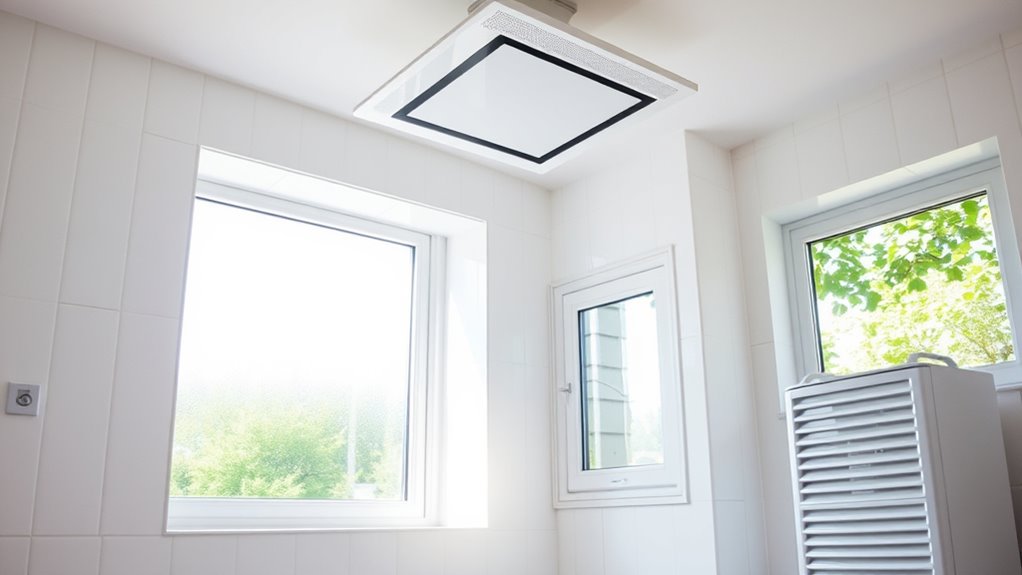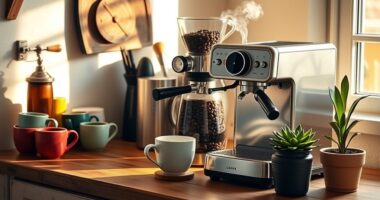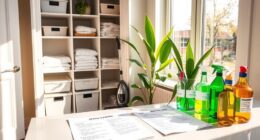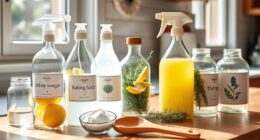To prevent mold and mildew in your home, focus on improving ventilation and controlling indoor humidity. Regularly open windows, use exhaust fans in kitchens and bathrooms, and keep humidity levels between 30-50% with a hygrometer and dehumidifiers. Fix leaks promptly and wipe away condensation on windows and walls. Maintaining a dry, well-ventilated environment makes it harder for mold spores to grow. Continue exploring effective tips to keep your home mold-free.
Key Takeaways
- Ensure proper ventilation by opening windows and using exhaust fans in high-humidity areas.
- Maintain indoor humidity levels between 30-50% with dehumidifiers and hygrometers.
- Fix leaks promptly and address damp spots to prevent mold growth.
- Regularly clean and inspect areas prone to moisture, like bathrooms and basements.
- Use vapor barriers and proper insulation to reduce condensation and moisture buildup.
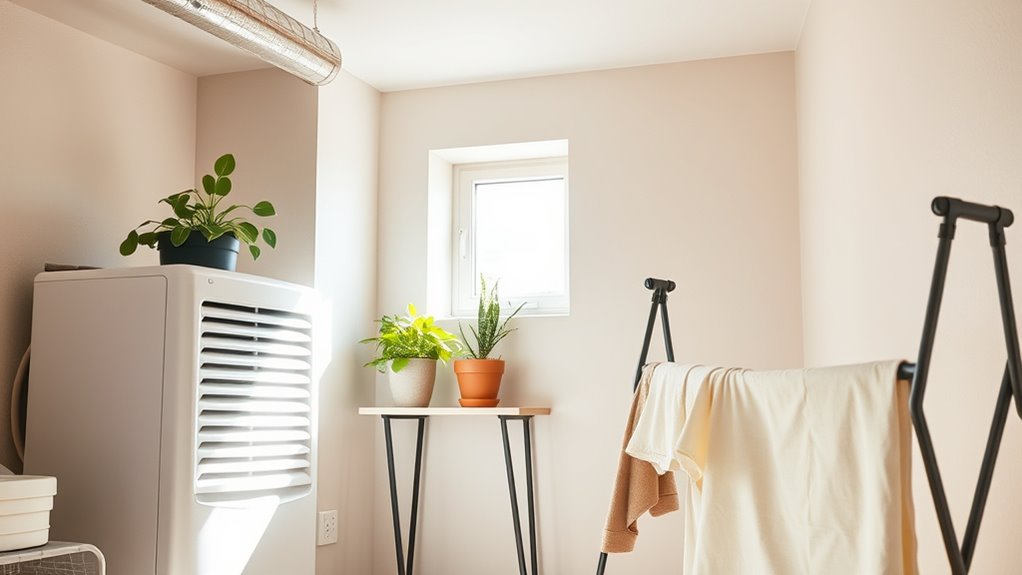
Mold and mildew thrive in damp, poorly ventilated areas, making it essential to take proactive steps to keep your home dry and well-ventilated. When moisture levels rise, mold spores settle and grow, often hidden behind walls or under carpets. To combat this, focusing on ventilation improvement is key. Ensuring proper airflow in your home allows moisture to escape instead of lingering, reducing the chances of mold development. Open windows regularly, especially in high-humidity areas like kitchens and bathrooms, to promote fresh air exchange. Installing exhaust fans in these spaces can critically improve ventilation and help draw out excess humidity. Additionally, consider upgrading your HVAC system with high-efficiency filters and ensuring vents are unobstructed to maintain steady airflow throughout your home.
Moisture control is equally crucial. Keep indoor humidity levels below 60%, ideally between 30-50%. Use a hygrometer to monitor these levels, and if you notice high humidity, employ dehumidifiers to remove excess moisture from the air. Fix leaks promptly, whether they’re from pipes, roofs, or windows, as even small leaks can create damp environments conducive to mold growth. Regularly check for condensation on windows and walls, especially during colder months, and wipe it away immediately to prevent mold spores from taking hold. When drying laundry indoors, avoid placing clothes on radiators or in damp areas, as this can increase indoor moisture and promote mold formation.
Controlling moisture isn’t just about equipment; it also involves habits. Keep bathroom doors closed when showering and use exhaust fans or open windows to expel humid air. When cooking, use range hoods or open windows to prevent steam buildup. In basements or crawl spaces, consider installing vapor barriers on floors and walls to reduce moisture seeping in from outside. Proper insulation can also prevent condensation on cold surfaces, which often leads to mold growth. Regularly inspect areas prone to dampness—around sinks, tubs, and under appliances—and address any issues immediately. Paying attention to proper ventilation techniques can significantly reduce the risk of mold and mildew in your home.
Frequently Asked Questions
Can Indoor Plants Cause Mold Growth?
Indoor plants can contribute to mold growth if they are overwatered or have poor drainage, increasing humidity and affecting indoor air quality. You should practice proper plant maintenance, like watering only when needed and ensuring proper drainage, to minimize mold risks. Monitoring humidity levels and improving ventilation also help prevent mold. Keeping your plants healthy and dry helps maintain a fresher indoor environment and reduces mold growth potential.
What Are Natural Remedies to Remove Mold?
When it comes to mold removal, natural remedies can be surprisingly effective. You might try using white vinegar, which gently tackles mold without harsh chemicals. Baking soda works as a mild abrasive and deodorizer, while tea tree oil offers natural antimicrobial properties. These options help you clean mold safely and naturally, keeping your home fresh. Embrace these gentle solutions to maintain a healthy environment without resorting to strong chemicals.
How Does Humidity Affect Mold Development?
Humidity levels directly impact mold development since high humidity encourages mold spores to grow. When humidity control isn’t maintained, moisture accumulates, creating the perfect environment for mold to thrive. You should aim to keep indoor humidity below 60%, ideally between 30-50%. Use dehumidifiers and proper ventilation to reduce excess moisture. By managing humidity, you prevent mold spores from settling and growing, keeping your home healthier and mold-free.
Are There Specific Materials Resistant to Mold?
You’ll find mold resistant materials and mold proof building supplies incredibly helpful. These materials, like mold-resistant drywall, treated wood, and special paints, prevent mold growth effectively. When choosing construction or renovation supplies, opt for mold-resistant options to reduce moisture problems. Using mold-resistant materials keeps your home healthier and easier to maintain, especially in areas prone to humidity. Incorporating these supplies is a smart step toward a mold-free environment.
How Often Should I Inspect Hidden Areas for Mold?
You should inspect hidden spaces at least once every three to six months. Regular inspection frequency helps catch mold early before it spreads. Focus on areas like behind appliances, inside cabinets, under sinks, and in basements. Pay close attention to any signs of moisture or musty odors. Staying proactive keeps your home healthier and prevents costly mold remediation later. Make inspections a routine part of your home maintenance.
Conclusion
By staying vigilant and following these tips, you can keep mold and mildew at bay and enjoy a healthier home. Remember to keep things dry, ventilate well, and fix issues promptly—no need to wait for a knight in shining armor to save your castle. Think of your home as your own personal fortress, where prevention is the best defense. With a little effort, you’ll maintain a fresh, mold-free space that’s as cozy as a well-worn leather armchair.
